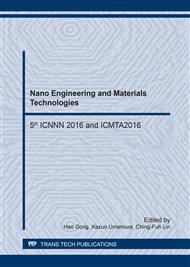p.13
p.19
p.24
p.32
p.37
p.42
p.48
p.55
p.59
Using Deionized Water with Ethanol as a Solvent of CuS EGFET as pH Sensor
Abstract:
In this research work, copper sulphide was deposited on glass substrate using spray pyrolysis deposition. The precursors were dissolved in deionized water (DIW) and ethanol, mixed at a ratio of 7:3. The distance between nozzle and substrate was 30 cm and the substrate temperature was maintained at 200 °C. XRD spectra analysis showed four distinctive peaks of high intensity, which indicate pure CuS covellite phase with average crystallite size of 28.3 nm. FESEM characterization of the thin film structure showed a mixture of very small nanoplates and larger square-and triangular-shaped particles. The application of the film as pH sensor showed it has exceptional qualities that include sensitivity and linearity of 22.9 mV/pH and 93.8%, hysteresis of 23.75 mV, repeatability (C.V.) of 0.11% for pH7, stability and reliability (C.V.) of 0.13%, 0.12% and 0.08% for pH 4, 7 and 10, respectively. This research work confirms the feasibility of using CuS thin film as extended membrane in pH sensor and biosensor applications.
Info:
Periodical:
Pages:
37-41
Citation:
Online since:
March 2017
Keywords:
Price:
Сopyright:
© 2017 Trans Tech Publications Ltd. All Rights Reserved
Share:
Citation:


